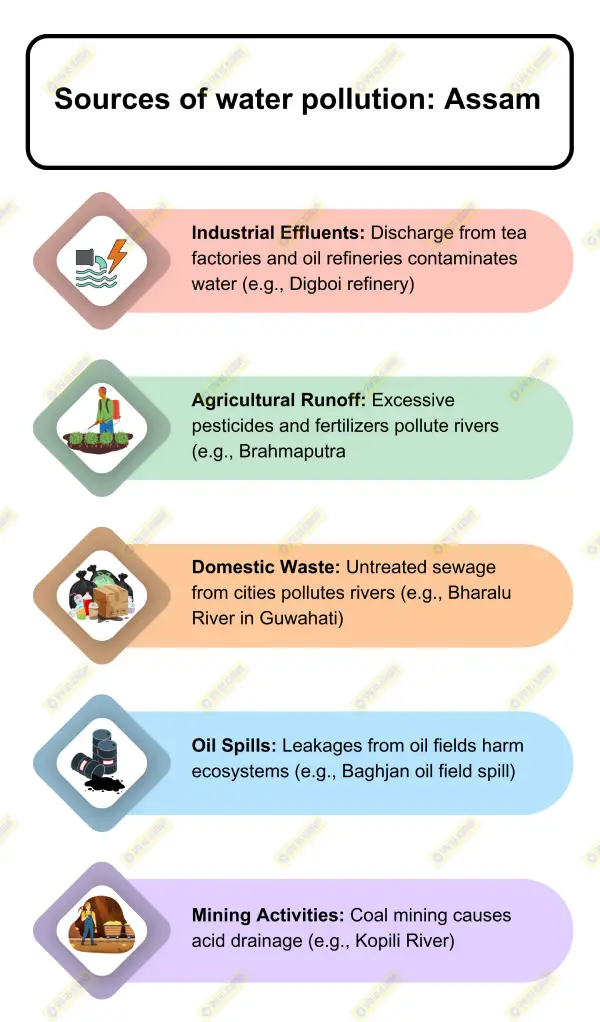The Water Quality Index (WQI) serves as a comprehensive measure of the health and usability of water resources. In Assam, where rivers like the Brahmaputra, Bharalu, and Kolong play crucial roles in agriculture, fisheries, and livelihoods, poor WQI has raised concerns about sustainability. The WQI integrates physical, chemical, and biological parameters to assess water safety for various uses. The persistence of low WQI in many Assam rivers highlights significant pollution challenges, underscored by CPCB and Assam Pollution Control Board (APCB) reports.
Parameters Contributing to WQI
- Physical Parameters
Temperature: Impacts dissolved oxygen levels; warmer water holds less oxygen, harming aquatic ecosystems.
Turbidity: Measures suspended particles; high turbidity affects light penetration and aquatic plant life. - Chemical Parameters
pH: Reflects acidity or alkalinity; extremes harm aquatic organisms and water usability.
Dissolved Oxygen (DO): Indicates water’s ability to support life; low DO suggests organic pollution.
Biochemical Oxygen Demand (BOD): High BOD reflects organic waste decomposition, often linked to sewage or effluents.
Nitrate and Phosphate Levels: Key indicators of agricultural runoff; excessive levels lead to eutrophication. - Biological Parameters
Fecal Coliform: Indicates contamination by human or animal waste, posing health risks.
Pathogens: Reflects bacterial and viral presence, critical for drinking water standards. - Heavy Metals
Presence of lead, arsenic, and mercury from industrial waste and mining activities poses significant risks to health and ecosystems.
Reasons for Poor WQI in Assam Rivers
- Industrial and Urban Effluents
Bharalu River: Acts as a drain for Guwahati’s untreated sewage and industrial waste, leading to high BOD and COD.
Urban areas contribute to 57% of polluted stretches in Assam rivers as per CPCB reports. - Agricultural Runoff
Rivers like the Kolong and Dhansiri face high nitrate and phosphate levels due to fertilizer runoff, causing eutrophication and biodiversity loss.
Example: Excessive algal blooms reduce oxygen availability, harming fish populations. - Deforestation and Erosion
Catchment area deforestation exacerbates soil erosion, increasing sediment loads in rivers like the Brahmaputra, resulting in high turbidity. - Oil Spills and Hydrocarbon Pollution
Frequent leaks from crude oil extraction and transportation in areas like Tinsukia and Dibrugarh contaminate rivers with hydrocarbons. - Illegal Mining and Acid Mine Drainage
Dikhow River: Coal mining leads to acid mine drainage, lowering pH and increasing heavy metal contamination. - Cultural and Religious Practices
Dumping of organic waste, idol immersions, and plastics during festivals degrade water quality in rivers like the Subansiri.
Reports and Data on Assam’s Water Quality
- CPCB’s Polluted Stretch Report:
Identifies rivers like Bharalu and Kalang with critical levels of BOD, COD, and fecal coliform. - Assam State Pollution Control Board (APCB):
Notes that only 28% of sewage is treated before discharge into rivers, significantly contributing to pollution. - World Bank Report on Brahmaputra Basin:
Highlights the role of rapid urbanization and poor waste management in degrading Assam’s rivers.
Examples of Poor WQI in Assam Rivers
- Bharalu River:
Severely polluted with industrial effluents and urban sewage; WQI classified as very poor. - Kolong River:
High nitrate and phosphate levels from agricultural runoff, causing frequent algal blooms. - Brahmaputra River:
High sediment load from deforestation and erosion, combined with untreated urban waste and oil spills.
The WQI of rivers in Assam reflects a combination of urbanization, industrial pollution, and agricultural practices. Strengthening sewage treatment infrastructure, promoting sustainable farming, and enforcing industrial discharge regulations are essential for improving WQI. Implementing CPCB recommendations and engaging local communities can ensure a cleaner and sustainable water future for Assam’s rivers.












